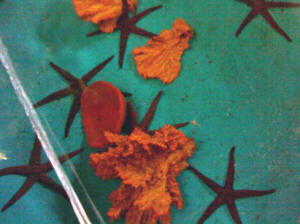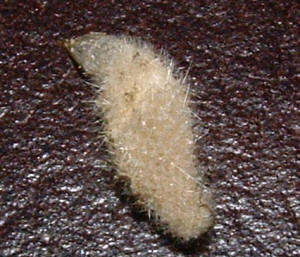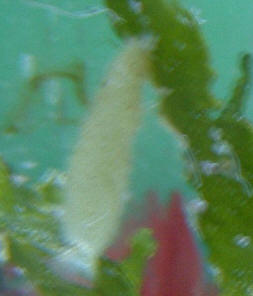|
FAQs about Non-Vertebrate Animal Identification
20
Related Articles: Marine Invertebrates, Quarantine of Corals and
Invertebrates, Feeding
Reef Invertebrates, Lighting
Marine Invertebrates, Water Flow, How Much
is Enough,
Related FAQs: Non-Vert IDs 1, Non-Vert IDs 2, Non-Vert IDs 3, Non-Vert IDs 4, Non-Vert IDs 5, Non-Vert IDs 6, Non-Vert IDs 7, Non-Vert IDs 8, Non-Vert IDs 9, Non-Vert IDs 10, Non-Vert IDs 11, Non-Vert IDs 12, Non-Vert IDs 13, Non-Vert IDs 14, Non-Vert IDs 15, Non-Vert IDs 16, Non-Vert IDs 17, Non-Vert IDs 18, Non-Vert. ID 19, Non-Vert. ID 21, Non-Vert. ID 22, Non-Vert. ID 23, Non-Vert. ID 24, Non-Vert. ID 25, Non-Vert ID 26, Non-Vert ID 27, Non-Vert ID 28, Non-Vert ID 29, Non-Vert ID 30 Non-Vert ID 31, Non-Vert ID 32, Non-Vert 33, Non-Vert ID 34, Non-Vert ID 35, Non-Vert ID 36, Non-Vert ID 37, Non-Vert ID 38, Non-Vert ID 39, Non-Vert ID 40, Non-Vert ID 41, Non-Vert ID 42, Non-Vert ID 43, Non-Vert ID 44, Non-Vert ID 45, Non-Vert ID 46, Non-Vert ID 47, Non-Vert ID 48, Non-Vert ID 49, Non-Vert ID 50, Non-Vert ID 51, Non-Vert ID 52, Non-Vert ID 53, Non-Vert ID 54, Non-Vert ID 55, Non-Vert ID 56,
Non-Vert ID
57, Non-Vert ID 58,
Non-Vert ID 59,
Non-Vert ID 60, Non-Vert ID 61,
& Marine Invertebrates, Marine Invert.s 2, Marine Invert.s 3, & FAQs about:
Marine Invertebrate Behavior,
Marine Invertebrate
Compatibility, Marine
Invertebrate Selection, Marine
Invertebrate Systems, Feeding
Reef Invertebrates, Marine
Invertebrate Disease, Marine
Invertebrate Reproduction, &
LR Life
Identification, LR Hitchhiker ID
1, Anemone Identification,
Aiptasia
Identification, Aiptasia ID 2,
Worm Identification, Tubeworm ID, Polychaete Identification, Snail Identification, Marine Crab
Identification, Marine Invert.s 1,
Marine Invert.s 2, Marine Plankton,
|

Algae, Bryozoan, UFO?
|
Worms or what.. and what to do? Maybe
eat'em! 1/23/07 Hi guys, <Hi there David, Mich
with you today.> I've tremendously enjoyed your site, and have
learned many great things. <Most excellent!> I have a
reef setup. About a week ago, I saw what looked to be "baby
snails" laid on the overflow. These were white, crusty,
corkscrew looking things. I scraped some off, and they were hard.
<Sounds more like feather dusters. Are they mobile?>
Tonight, after the main tank lights went down, I was watching my tank
(cool things happen at night under the moonlights) <Yep!>, when I
noticed some filamentous worms wiggly around, up toward the lights. I
dipped one out, and this thing swam around for about 30 minutes, before
apparently dying. These things swim like a sea snake. They are about
1/2" long, and kind of a light brown color. <Cool!> Any idea
what these are? I searched high and low for photos, without
luck. <Could be any of several thousand types of polychaete
worms. Bob tells a story in the Reef Invertebrates book
about swimming polychaetes, actually epitokes, that he encountered as a
boy growing up in the Philippines. Bob, and other locals
would gather and eat this delicacy!> In my tank I have a Hippo Tang,
Foxface Rabbitfish, Golden Wrasse, Neon Dottyback, Lawnmower Blenny,
Cleaner Shrimp, Banded Starfish, Emerald Crab, Strawberry
Crab, and lots of snails. The only fish acting a bit weird
is the Hippo Tang (and I see why they modeled "Dory" after
this fish, it just acts weird), which has been scratching on the
rocks. All fish's appetites are good. I feed
frozen food (mysis, reef plankton, ground krill, + refugium
algae). <Good.> Should I put my fish in my QT tank
and treat them? <Why? Treat them for
what?> I've only been up and running for about 3 months, with no
problems to date. However, it looks like these "baby snails"
are parasites getting ready to hatch. <Mmm, not likely.> Sorry,
but I have no photos. <I think your concerns are misdirected.>
Thanks!! <Welcome! -Mich> David
White hair patches on rocks and glass
1/23/07 I have had my 25 gallon FOWLR tank for a year
now. A few months back I noticed a white fuzzy substance on the glass
and some areas of the rock. There way more on the glass then the
rocks. It almost looks like a fungus. The hairs are so thin
you can't see just 1 strand. It looks like smoke as it waves around
in the current. I've been wiping it off with my mag float.
Everything seems to be doing fine but I wondered if you knew what this
could be and if I should worry about it. <Very likely some type of
worm... yes, they come this thin... But could be a bunch of other
things... Wish you had an inexpensive scope (maybe a QX series... see
the Net, WWM re). Bob Fenner>
Sponge-like creature ID, please?
1/23/07 Dear Crew, <Hi from HI
Patty, Mich here today.> Greetings from the
Caribbean! First, I would like to thank you all for such a great
source of information. <Welcome, glad you have found it
useful.> My father has been spearfishing (responsibly) for about
40 years and because of this, I have always been around the sea and
interested in sea creatures. <Wonderful!> We are very lucky
to live in Puerto Rico. <Yes, warm and sunny by the ocean with
amazing sea life... what's not to like?>
About 6 months ago, I started a small (10 gallon)
saltwater tank (I was able to set it up thanks to your site, btw.
So, thank you!) <Very good!> with sole purpose of keeping a
fish that resembles the Whitetip Soldierfish on your site. I went
with my father to collect it ourselves. The fish is super lively
and doing great it only comes out to eat or at night, though).
He's just gorgeous! I call him Candil (that's also the
local name for that sort of fish around here).
<Cool!> My husband brought me a
small rock from the beach to decorate the tank and we found a
surprise. After a few hours in our little quarantine tank, we saw
something that looks like a honeycomb; It's about the size of a
nickel, orange and has about nine openings that open throughout the
day. I attached the image with this email. Do you guys and gals
think you could help me identify it? <Mmm, Bob has some pics of
these things from Sulawesi, he spent quite some time trying to
figure out what it was and ended up filing it under
misc. Some possibilities include sponges, Ascidians/Sea
Squirts, bryozoans, stinging cell organisms and the one Bob thinks
is most likely is actually an algae, maybe something like the
Phaeophyta Colpomenia. He said what he saw felt a bit
rubbery. Because he suspects it is a brown algae, he
recommends dosing the tank weekly or concurrently with water
changes with Iodine (Iodide/Iodate), even more so because you are
using natural sea water.> I really think it's some sort of
sponge. I looked through the FAQ's and can't find anything
that looks quite like it. <Yes, a bit of a
challenge!> While I love to look
at this creature, I would also like to know if I can keep it or if
we should bring it back. Although it's nice, it would be a
crime for this creature to suffer on my account. I am lucky enough
to be able to get fresh sea water weekly I change one gallon
weekly). I collect it exactly from where I caught my fish) and I
have 50/50 fluorescent-actinic03 blue lights. Is this enough to
keep the little sponge? <It's hard to say what the care
requirements are without being able to identify it. I
would watch it and if it seems unhappy return it to it's
natural home. Good luck with it!> Thank you all in
advance for your time and help. <Welcome, my
pleasure.> Best regards,
<Aloha! -Mich>
Patty S. |
| Re: Sponge-like creature ID,
please? 1/26/07 <Hello Patty,
Mich with you again.> Thank you for your help! <You are quite
welcome! Upon further discussion and review another
possibility came to light. Your addition might be a
colonial ascidian or sea squirt or possibly sea pork, maybe
Amaroucium stellatum. -Mich> Patty |
|

|
White fluffy things - 1/22/07 Good
Morning Crew <Hello Kerryn, and a good morning to you!> I have a
new problem in my marine tank I can't identify the species,
I've asked LFS they don't have a Scooby either, I cant find a
picture to help me identify what it is. <Haha, I can't help but
giggle a little at that one... I've never heard of a clue referred
to as a "Scooby", do hope you don't mind if I borrow and
add this to my repertoire! *grin* As far as identification goes, I will
give it a try!> Little white fluffy things are growing on power
heads - inside the protein skimmer and on some dead coral skeletons.
These little white fluffy things don't move they but are
multiplying rapidly. I have tried to rid them out of the tank by taking
skeleton corals out and scrubbing power heads. They are easily removed
(squished) <Sounds like a hitchhiker sponge that is thriving in your
aquarium. I would consider these beneficial, they are filter feeders,
helping 'naturally clean' your water.> Everything was going
well I bought a couple of snails six weeks ago this is the only thing
that has been added to the tank for months everything I have purchased
is from the same marine shop. <Holy run-on sentence, Batman!
Everything sounds fine here, Kerryn.> What could it be and how can I
get rid of it. What I've been doing hasn't helped? Your help
will be Greatly appreciated. Kerryn. <Well, Kerryn, I would continue
doing as you are if they are a major visual nuisance. Otherwise, I
would leave all be, as they will likely only benefit your tank. Hope
this helps! -JustinN> Tank size 600 litres - 6ft by 2 by 2 Mostly
Corals and Live Rock Three clowns Nemo - Marlin - Coral Two
Yellow Tangs Two Blue Tangs - Dory 1 - D-2 Two Dotty Backs Canister
Filter Two Power heads Marine Lighting that is a year old AND A MANTIS
SHRIMP.
| Identification Dear Mr. Fenner <Just Bob
please> I need a big help in identifying these animals.
<Okay> I am sending you 6 pictures as attachments. There are
two orange color corals. One looks like a hard coral and the other
looks like a small orange cone but I really don't know what
these are. <Mmm, these aren't corals hon... they're
sponges, Poriferans... at a wholesalers by appearances> Could
you please let me know the scientific names for these two corals?
<See WWM, elsewhere re sponges... these ones are
non-photosynthetic... but not easily kept... have a
"dark" side... as you will find> And let me know
whether they are hardy corals. <Sigh....> Also I have sent
you a picture of a Blue boxfish fish which is available in the pet
store. Could you please let me know the scientific name for this
boxfish and let me know whether it is a good addition for my 85G
tank which contains 4 blue damsels, 2 medium clarkii clownfish and
a lunar wrasse? Thanks in advance. <Is a male Ostracion
meleagris... please see WWM... BobF> Best regards,
Akila |
|
 .jpg)
|
Nudibranch?...Hmm, a Cuke I Think - 01/19/07
Hi Bob, <<Eric here today>> I have been looking online
for days and cannot identify what I think is a
Nudibranch. It was a hitchhiker with a button
polyp. Sorry it's out of focus, but I can try again
if it's not clear enough to ID. <<Hmm...>> I know
they're hard to keep as I made the mistake of buying
a Nudibranch once and it wasn't until after it died
a few weeks later that I found out that they don't do well in
tanks. <<Indeed...many/most are very strict obligate
feeders>> I don't want to make the same mistake
again! Any help you can give me would be most
appreciated by both of us :) <<Well Susan, this actually
looks to me to be a Holothuroid, a sea cucumber...perhaps
Holothuria thomasi. Have a look here and see what you
think: http://www.wetwebmedia.com/seacukes.htm >>
Regards,
Susan
<<Cheers, EricR>> |
Re: Nudibranch?...Hmm, a Cuke I Think -
01/20/07 Hi Eric, <<Hello Susan>> That looks to be
my hitchhiker. <<Cool!>> I looked at a few posts of
people with these asking if they are safe and also if it is safe
for them to be in the tank. <<Are fine, in my
opinion/experience>> Not sure I got a clear answer, any
thoughts? <<Yep... I don't wish to understate
the toxicity issues of these creatures or the devastation such an
event can wreak in a closed system, but I have kept Holothuroids
(have three different species in my tank right now) without
incident since entering the reef-side of the hobby 17-years
ago. Certainly some species are best left alone/only
attempted by expert aquarists such as the genus Pseudocolochirus
(Sea Apples) and some of the other brightly colored
"suspension feeders," but there are some "deposit
feeders" that I feel do quite well and also present a lesser
degree of danger from tank poisoning. One of these is
what I believe you have, Holothuria thomasi or the Tiger-tail
cucumber. As long as nothing is attacking/bothering the
cucumber and you afford adequate food availability to preclude
starvation, I feel you have little to fear>> I have a small
24-gallon tank. <<These critters don't grow exceedingly
fast...one specimen should do fine for quite some time in this
tank>> Should I take him back to the LFS? <<Is up to
you...but were it me, I would keep/watch/study this interesting and
beneficial detritivore>> Thanks again for your help!
Susan
<<A pleasure to share. Eric Russell>> |
|

|
| Mystery Pod... worm? 1/16/07 Hi
Crew, <Laurie> Would any of you folks know what the pod in
the attached pictures is? <Mmm, not a "pod" as in a
crustacean... appears to be a type of tubiculous worm...> The
first photo is of a pod that I removed from the
water. As you can see, the texture is prickly, and it
sort of has a "crown" on the one end.
<Yes... is this thing ambulatory? That is, does it move?> The
second photo shows a very large pod attached to a Halimeda in my
algae scrubber (sorry for the blurriness of this one). I
have not been able to identify these. I just want to be
sure that these are not harmful. <Mmm, are not harmful... make
their own tubes... for protection... are filter feeders> I have
no idea if they are plant or animal or something in between. Thanks
much! Regards, Laurie Ostrander <Animals, Annelids, Polychaetes,
Sedentariates... Bob Fenner> |
|
 
|
|
|

